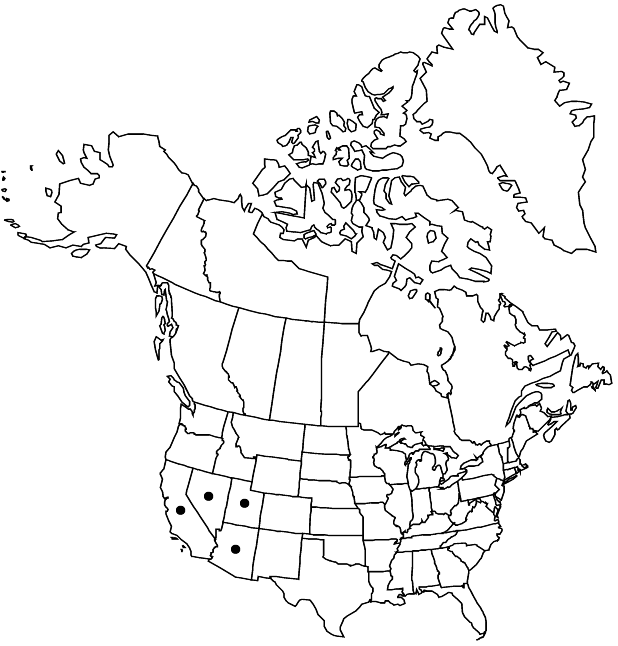Dudleya arizonica
Addisonia 8: 35, plate 274. 1923 ,.
Caudices simple, 1–15 × 1–4 cm, axillary branches absent. Leaves: rosettes solitary, not in clumps, 10–35-leaved, 5–30(–60) cm diam.; blade ± chalky white, in age often red, oblong to oblong-obovate, 3–17[–30] × 1–7 cm, 2–4 mm thick, base 1–3.5 cm wide, apex acute or usually long-acuminate, surfaces not farinose, chalky. Inflorescences: cyme 3–6-branched, cylindric; branches (mostly ascending), twisted at base (flowers on underside), simple, (3–7 cm wide); cincinni 2–5, 4–20-flowered, circinate, 4–27 cm; floral shoots 15–60 × 0.2–0.6 cm; leaves 5–25, spreading, cordate-ovate to almost deltate, 10–35 × 5–25 mm, apex acute to acuminate. Pedicels mostly erect or ascending from bud to fruit, rarely spreading to pendent, in fruit often bent upward near or above middle, 5–20 mm. Flowers: calyx 4–7 × 4–7 mm; petals connate 4.5–8 mm, red to apricot yellow, 9–15 × 1.5–2 mm, apex obtuse to sharply acute, tips outcurved; pistils connivent, erect. Unripe follicles erect. 2n = 34.
Phenology: Flowering spring.
Habitat: Dry, rocky slopes and canyon walls in desert mountains
Elevation: 100-1100[-1500] m
Distribution

Ariz., Calif., Nev., Utah, Mexico (Baja California, Sonora).
Discussion
The diploid Dudleya arizonica is closest to the diploid D. pulverulenta, looking like a reduced desert form, smaller in most parts, or sometimes like a seedling. Northward, the ranges are well separated, and southward in Baja California, where both are more sporadic, the ranges and the plants seem mainly distinct. Southward, D. pulverulenta makes large plants like those in the far northern part of its range, whereas southward D. arizonica generally is smaller and less like D. pulverulenta and more like just any old dudleya. In eastern San Diego County, California, the two intergrade and it is hard to draw a line between them. In coastal San Diego County, California, the type region, plants of D. pulverulenta are generally smaller and less extreme than those to the north and south and a little more like D. arizonica. For these reasons, I formerly treated D. arizonica as a subspecies (R. V. Moran 1943b), and something may still be said for that treatment. Because they are generally quite different through much of their broad ranges, it seems better to treat them as different species.
The inflorescence of Dudleya pulverulenta and D. anthonyi Rose is approached in some plants of D. arizonica. The mostly ascending branches are sometimes twisted at the base, putting the flowers on the abaxial side, the flowers are sometimes spreading or even pendent, and the fruiting pedicels commonly are more or less bent upward. Because the leaves are fewer and, with the thinner caudex, narrow at the base, seedlings of D. pulverulenta may closely resemble adult plants of D. arizonica.
Selected References
None.